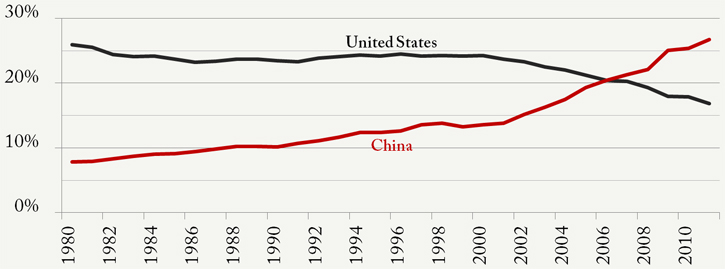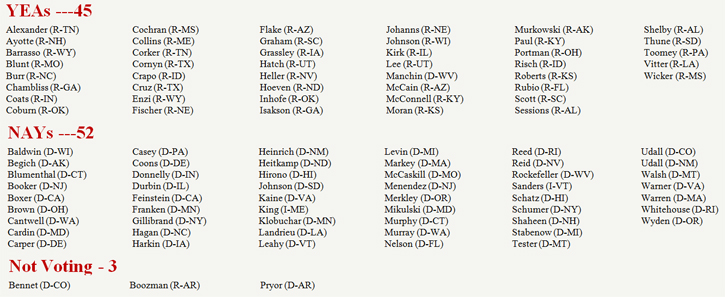Democrats’ National Energy Tax: Costing Jobs and Squeezing the Middle-Class
Today, the Obama administration unveiled the centerpiece of its agenda to impose a national energy tax on the American people. The administration will require states to severely restrict carbon emissions from existing power plants, radically curtailing coal’s share of electricity generation. This will raise energy prices, undermine electric reliability, and destroy jobs – effectively slamming the brakes on the American economy.
U.S. share of world carbon emissions plummets, China’s soars

Destroying Economic Opportunity
Electricity prices have risen steadily over the past 5½ years, and are projected to mount even higher. More than 19 million Americans are unemployed, underemployed, or have given up hope of finding a job, and the labor force participation rate has fallen to its lowest level since 1978.
A well-developed body of literature shows that both high energy prices and endemic unemployment seriously harm public health. Rising energy prices act as a regressive tax, hurting low-income families and fixed-income seniors the most. Energy represents a larger portion of
their household budgets, leaving them with less to spend on food, housing, health care, and other basic necessities.
The president should focus on lowering electricity prices and creating jobs. His administration’s plan to scale back coal-fired power from our nation’s energy mix would make electricity more expensive and destroy economic opportunities for millions of Americans. A recent study by the U.S. Chamber of Commerce found that an aggressive carbon emissions reduction scheme targeting coal-fired power plants would lead to higher electricity bills, reduced disposable income for families, and thousands of job losses.
A modern economy cannot function unless homes and businesses can rely on uninterrupted, affordable electricity at all times. In response to unfavorable market conditions, largely created by the president’s anti-coal regulations, many coal-fired plants will be shut down in the coming years. Last winter, American Electric Power called on 89 percent of its coal-fired power plants slated for closure, just to keep electricity flowing to its customers. Southern Company called on 75 percent. Without their coal-fired electricity, lights may not turn on and heat pumps may not bring warmth during the next cold snap.
Phillip Moeller, a member of the Federal Energy Regulatory Commission, confirmed in April that “the experience of this past winter indicates that the power grid is now already at the limit.” He explained: “We can hope for mild winters and summers over the next several years, but hoping for mild weather is not a practical method of planning to meet economic growth and public safety.” Neither is the president’s proposal to shut down existing coal-fired power plants.
No Flexibility for Energy Consumers
The administration claims states will be given ample “flexibility” to choose for themselves which carbon-reduction measures to implement in order to comply with the rule. But flexibility in this context is little more than an invitation for states to choose the method by which their economic wounding will be performed.
To meet carbon reduction obligations, a state might shut down coal-fired power plants, impose a carbon tax, develop a cap-and-trade program, require more renewables, or mandate energy rationing. Their options will be limited – and virtually all of those options will mean imposing a carbon tax on affordable, reliable, and abundant fossil energy. Energy consumers will not enjoy even that much flexibility to cope with the higher prices.
Over the past decade, Europe has pursued exactly the kind of flexibility the president offers the states. Seeking drastic reductions in carbon emissions, European countries have imposed burdensome mandates, cap-and-trade regimes, green energy subsidies, and other programs. As a result, electricity prices in Europe are now far higher than in the U.S.
In 2012, each kilowatt hour of residential electricity cost 12 cents in the U.S., 26 cents in the European Union, and a staggering 35 cents in Germany, according to a February 2014 Manhattan Institute report. Between 2005 and 2013, the average price in the EU rose by 55 percent. Germany’s program to transition to renewable fuels has been an abject disaster, and the country
now has plans to build 10 new coal power plants. It remains unclear why the president and other Democrats still insist on following the treacherous path laid out by Europe.
Massive Costs, Negligible Benefits
President Obama once characterized his election as “the moment when the rise of the oceans began to slow and our planet began to heal.” But by then, the U.S. share of global carbon emissions already had been declining for nearly a decade – from 25 percent in 2000 to 19 percent in 2008. These declines occurred without expensive, burdensome, and unworkable policies pushed by the president and other Democrats.
The declines have continued since 2008, due to market forces, not government action. A primary reason has been increased electricity production from low-carbon natural gas, made possible by technological innovations in horizontal drilling and hydraulic fracturing that halved its price.
Meanwhile, carbon emissions in China, India, and other developing countries are skyrocketing. China’s carbon emissions exploded by 173 percent from 1998 to 2011 and are projected to continue growing. India’s emissions could surpass China’s by 2020. If growing global carbon emissions are indeed a problem, the president and other Democrats should quarrel with China, India, and other developing nations, not American energy producers and consumers who are already doing their fair share.
Ironically, policies like the president’s proposed rule may not be the most effective way to reduce carbon emissions anyway:
- By raising energy prices and stunting economic growth, less wealth will be available to develop and consume innovative technologies that allow fossil fuels to be burned more cleanly, or wind and solar to produce power more efficiently, or battery systems to store energy more effectively. It is no coincidence that between 1980 and 2012 America’s GDP soared by 133 percent and aggregate emissions of the six common pollutants plummeted by 67 percent – all while population, energy consumption, and vehicle miles traveled rose.
- Europe’s experience demonstrates that the flexibility the president offers to the states to comply with the rule may do little to reduce carbon emissions. According to the Manhattan Institute report: “For its higher electricity costs, Europe has not received the benefit of higher carbon-emissions reductions: between 2005 and 2012, U.S. carbon dioxide emissions fell more than those of the EU did. Furthermore, in 2012, Germany’s carbon dioxide emissions actually rose by 1.3 percent over 2011 levels, while U.S. emissions fell by 3.9 percent.”
- The U.S. Chamber of Commerce predicted that the U.S. experience could closely follow Europe’s if an aggressive carbon emissions scheme targeting coal-fired power plants is implemented – incurring substantial costs in return for negligible environmental benefits.
The only certain beneficiaries of the president’s proposed rule and his larger regulatory war on fossil fuels are likely to be the green energy venture capitalists and major political contributors to Democratic campaigns. Many of them have passed through the revolving door of the Obama administration, influencing the government’s anti-fossil fuel policies before returning to the private sector to profit from them.
Tom Steyer, a billionaire venture capitalist, has committed $100 million to defeat congressional candidates who support fossil fuels so Congress will pass policies that support his green energy investments in the future. It is no surprise that Steyer made millions off of fossil fuels before turning his fire against them.
Senate Democrats Protect the President’s Anti-Fossil Fuel Agenda
Democrats have used their control of the Senate to protect the president’s anti-fossil fuel agenda. Last month, Senate Republicans sought votes on amendments to approve energy projects like the Keystone XL pipeline that are being blocked by the president. Democrats voted against a Republican motion to make room on the amendment tree for legislation offered by Senator McConnell that would prevent the administration from imposing unworkable carbon emissions reductions on new and existing coal-fired power plants. Even energy-state Democrats sided with their party leadership instead of their constituents.
Democrats block McConnell Amendment 3013

Since 2009, the president and congressional Democrats have promoted spending, regulatory, and policy steps to reduce U.S. carbon emissions in the name of tackling climate change. They have tried to exploit federal power to shape the U.S. marketplace to give “green” energy an advantage over conventional fuels, while dismissing Republican proposals that would have advanced both.
Republicans will keep working to support energy sources that provide Americans with economic and social benefits. But energy-state Democrats must join Republicans in their fight against the administration’s policies. They must force the president to retreat from his regulatory war on fossil fuels. Anything less is just playing politics with the energy needs of average Americans.
Next Article Previous Article
